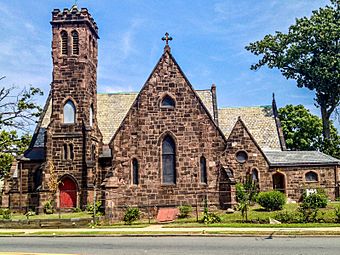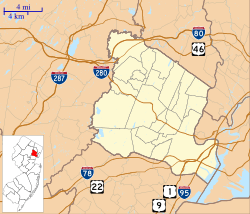St. Barnabas' Episcopal Church (Newark, New Jersey) facts for kids
|
St. Barnabas' Episcopal Church
|
|
 |
|
| Location | West Market Street and Sussex and Roseville Avenues, Newark, New Jersey |
|---|---|
| Area | 1 acre (0.40 ha) |
| Built | 1864 |
| Architect | Thomas A. Roberts |
| Architectural style | Gothic |
| NRHP reference No. | 72000785 |
Quick facts for kids Significant dates |
|
| Added to NRHP | October 18, 1972 |
St. Barnabas' Episcopal Church is a historic building in Newark, New Jersey. It was built in 1864 and became a recognized historic place on October 18, 1972. This means it is an important landmark in the United States.
Contents
The Church's Early Days
The story of St. Barnabas' Church began on September 12, 1852. The first church service was held in a house. The church officially started the next year. A person named William Dusenberry was very important in helping to create the church.
In 1853, land was given for the church and a school. The agreement said that a church and school must be built there. The church building would always be used for worship according to the rules of the Protestant Episcopal Church. A Sunday school for children also started on October 9, 1852.
Building the Church
The first church building was made of wood. It was dedicated in 1855. Sadly, this wooden church burned down in 1862.
The current church building is made of stone. It was dedicated on St. Barnabas' Day in 1864. Parts of the church, called transepts, were added in 1869. The rectory, where the church leader lives, was built in 1869. A parish house, used for church activities, was added in 1889. The porch at the main entrance was built in 1913.
Community Involvement
St. Barnabas' Church has always been active in its community. Many groups and programs have used the church's facilities over the years.
Helping the Sick
In 1865, a group of women from the church started the Ladies Society of Saint Barnabas. They helped create Saint Barnabas Hospital. The first patient, Eliza Titus, even gave her property to help start the hospital. It first opened on McWhorter Street in Newark. The hospital later moved to High Street in 1869. In 1964, it moved to Livingston, New Jersey.
Support During Hard Times
During the Great Depression in the 1930s, St. Barnabas Church was very strong. It had over 500 members. The church supported two priests and two organists during this difficult time.
Civil Rights Activism
One of the church's leaders, Rev. Robert Laughlin Pierson, was a priest from 1960 to 1967. He was involved in the Freedom Rides in 1961. These rides were important events during the Civil Rights Movement. Rev. Pierson and other priests worked to end unfair treatment based on race. He believed strongly in fairness for everyone. His actions brought national attention to the cause.
Rev. Pierson and his wife, Ann Clark Rockefeller, were very interested in social causes. They supported racial equality and women's rights. They also helped migrant workers. They even traveled to Moscow in 1965 to help improve relations during the Cold War.
Youth and Community Programs
In the 1970s, the church's basement had a coffee house called "The Edge." It was a popular place for young people in the neighborhood. Also in the 1970s, the North Porch Women & Infants Center started at St. Barnabas. This center helps women and babies. It later moved to a different location.
In the 1980s, the gymnasium in the parish hall was used for youth programs. The Share program also began in the 1980s. This program grew into a food pantry that still gives out food twice a week today.
Later, from 1990 to 2007, the Aids Resource Center was located in the church's parish hall basement. Today, the basement houses the Jamar Carter Operation Turnaround boxing gym.
Recent History
In November 2012, the church's congregation moved from the building.
See also
 In Spanish: Iglesia de San Bernabé (Newark) para niños
In Spanish: Iglesia de San Bernabé (Newark) para niños




